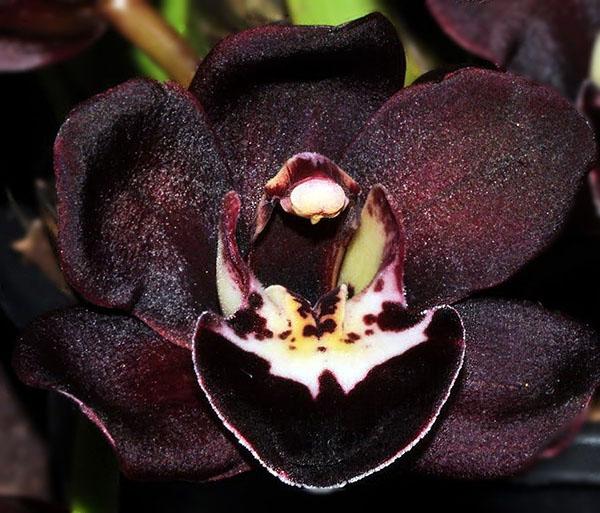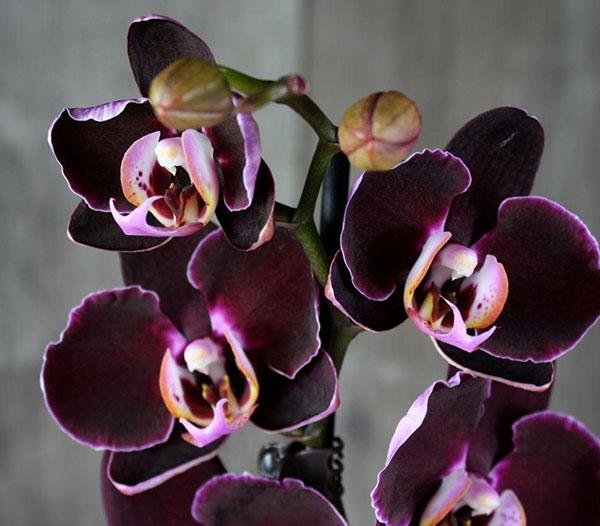Exotic black orchid: description, care features, diseases and pests
 Original tropical plants have wonderfully taken root on the windowsills of our compatriots. Many are attracted by the spectacular black orchid, which causes an unprecedented delight in everyone who has seen it. In Europe, the flower began to be actively cultivated in the 19th century. Biologists believe that black pigment does not exist in the natural environment. Therefore, black orchids include species that are painted in dark tones of purple, purple or burgundy.
Original tropical plants have wonderfully taken root on the windowsills of our compatriots. Many are attracted by the spectacular black orchid, which causes an unprecedented delight in everyone who has seen it. In Europe, the flower began to be actively cultivated in the 19th century. Biologists believe that black pigment does not exist in the natural environment. Therefore, black orchids include species that are painted in dark tones of purple, purple or burgundy.
What is remarkable about the black orchid when you get to know each other

Each type of flower is different:
- the shapes of the petals of the buds;
- plant height;
- the size of the leaves;
- aromas.
In their natural environment, they are found among thickets of tropical forests, on mountain slopes and even in savannas. Black orchids are epiphytic plants. They attach themselves by their roots to other species of their relatives, and absorb nutrients from the air. Consider several popular varieties of indoor black orchids.
The scientific name of the plant is phalaenopsis.
His Majesty Black Prince orchid variety
 The species is characterized by deep purple buds. They reach 7 cm in diameter. The core is lighter in color. The number of buds varies. It all depends on the growing conditions of the orchid. The height of a single stem does not exceed 47 cm. The plant receives nutrients through the root system and leaves.
The species is characterized by deep purple buds. They reach 7 cm in diameter. The core is lighter in color. The number of buds varies. It all depends on the growing conditions of the orchid. The height of a single stem does not exceed 47 cm. The plant receives nutrients through the root system and leaves.
Bright lightning
 The main difference between the variety is narrow sheet plates with a figured frame. The color of the buds is deeply dark. Emits a pleasant aroma during flowering. It grows to about 45 cm.
The main difference between the variety is narrow sheet plates with a figured frame. The color of the buds is deeply dark. Emits a pleasant aroma during flowering. It grows to about 45 cm.
Black Pearl
 This species was bred relatively recently. It has 4 peduncles. Dark green leaf plates are elongated. During the period of lush flowering, about 15 dark purple buds are formed on the bushes. Each of them smells good. When the black orchid flower fully blooms, it resembles ordinary tulips. Their diameter is about 5 cm.
This species was bred relatively recently. It has 4 peduncles. Dark green leaf plates are elongated. During the period of lush flowering, about 15 dark purple buds are formed on the bushes. Each of them smells good. When the black orchid flower fully blooms, it resembles ordinary tulips. Their diameter is about 5 cm.
Cat's eye
 The plant has only one peduncle, which will grow up to 40 cm. The buds consist of several dense petals of dark blueberry color. When you look at the flowers from the side, it seems that they are covered with a layer of wax. An incredibly beautiful sight!
The plant has only one peduncle, which will grow up to 40 cm. The buds consist of several dense petals of dark blueberry color. When you look at the flowers from the side, it seems that they are covered with a layer of wax. An incredibly beautiful sight!
How to care for an exotic beauty
 Since the black orchid came to us from the tropics, its cultivation should be treated carefully and wisely. Some species require special care. Still, the basic principles apply to any plant.
Since the black orchid came to us from the tropics, its cultivation should be treated carefully and wisely. Some species require special care. Still, the basic principles apply to any plant.
Lighting
 First of all, comfortable conditions are created for the flower. It develops wonderfully in a warm and bright room. As a rule, flowerpots are placed on windowsills. However, leaf plates can suffer from direct sunlight.
First of all, comfortable conditions are created for the flower. It develops wonderfully in a warm and bright room. As a rule, flowerpots are placed on windowsills. However, leaf plates can suffer from direct sunlight.
At noon, black orchids are transferred to shaded areas.
Watering
 The main feature of caring for a black orchid is moderate moisture. The plant does not like extremes. It can be damaged by both prolonged drought and abundant watering. Experts advise to moisten the plant no more than 3 times a week in summer. In winter, it is enough 1 time for 7 days.
The main feature of caring for a black orchid is moderate moisture. The plant does not like extremes. It can be damaged by both prolonged drought and abundant watering. Experts advise to moisten the plant no more than 3 times a week in summer. In winter, it is enough 1 time for 7 days.
Water the orchid only after the substrate has completely dried. Otherwise, the root system of the plant will suffer from excessive moisture.
Suitable substrate
 When choosing a soil for any plant, you should consider its origin. The black orchid came to us from the tropics, so the soil should be loose. The most commonly used are pine bark, peat moss, or vermiculite.
When choosing a soil for any plant, you should consider its origin. The black orchid came to us from the tropics, so the soil should be loose. The most commonly used are pine bark, peat moss, or vermiculite.
Top dressing
 Phalaenopsis needs additional nutrients during budding. In flower shops you can find special fertilizers for orchid plants. Following the instructions, the substance is added to clean, settled water, after which the surface of the substrate is moistened.
Phalaenopsis needs additional nutrients during budding. In flower shops you can find special fertilizers for orchid plants. Following the instructions, the substance is added to clean, settled water, after which the surface of the substrate is moistened.
Common diseases and pests of black orchids
 How sad it is when a tropical beauty loses its original appeal. Leaf plates are the first to suffer. They turn yellow and fade unnaturally.
How sad it is when a tropical beauty loses its original appeal. Leaf plates are the first to suffer. They turn yellow and fade unnaturally.
They appear:
- cracks;
- growths;
- dark spots;
- marbled color;
- red dots.
 The root system, stems, buds and flowers are often affected.
The root system, stems, buds and flowers are often affected.
The following diseases are the cause:
- late blight;
- brown, dry and white rot;
- phomopsis;
- rust;
- alternaria.
To return the flower to its former beauty, treatment is carried out. For this, special preparations are used, using the instructions provided.
The affected flower should be isolated from other plants until fully restored.
Unfortunately, black orchids are affected not only by diseases, but also by pests. They settle on the substrate or the plant itself.
The most common are:
- ticks;
- thrips;
- moths;
- scabbards;
- aphid;
- slugs;
- midges;
- springtails;
- podura.
All kinds of insecticides that are sold in specialized stores will help get rid of them. Only timely treatment will protect the black orchid from hated pests.
How to attach a photo, I can't understand what happened to my flowers, some of my phalaenopsis have tubercles, 1-3 from the bottom of the leaf, on the lowest ones, they are not next to each other in a bunch, but at such a good distance. I don't know what it is, and whether it is necessary to fight it. I have not observed insects, and I do not know how they should look, I am not experienced in this matter.